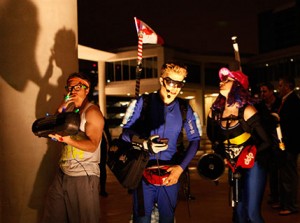The great thing about radio technology is that it’s one of the most efficient ways to broadcast a message. Less than a watt of power can send a signal to hundreds of people over an area the size of a city block or two with ease. By comparison, if you tried to text a few hundred people simultaneously in the same area you’d probably oversaturate the cell towers and briefly bring the network to its knees. Anyone who has struggled with cell connectivity while attending a big festival or event knows what that’s about.
This past Saturday at SXSW in Austin the Decentralized Dance Party took their low-powered transmitters to the street and handed out boomboxes to revelers who helped create a sound system without a PA. Wired News’ Angela Watercutter was there and describes the scene:
As the party moved around Austin’s downtown core, Gary controlled the music from an iPod in his fanny pack and MC’d from a mike hanging from his ear. The music, along with Gary’s instructions to the crowd, was piped to all of the individual boom boxes — some constructed out of suitcases — using a pair portable FM-transmitters. The mobile radio transmitters, with their candy-cane-looking antennas, were strapped on Gary’s back and the back of another young woman. The various boom boxes, including giant one carried by the mustachioed Tom, were all tuned to the proper frequency to pick up the broadcasted signal. Voilà: Instant party.
This kind of broadcast can be pulled off with legal low-power transmitters of the sort used by fitness clubs and real estate agents to cover an area of less than a quarter mile. Putting aside the cost of boomboxes, if you make it a BYOB affair the cost can come in much lower than a big PA. Plus, you can probably skirt permit rules for sound systems, that are typically based on total audio power output.
Portable low-power transmitters have been used to provide an efficient means of communication, information and music during protests, parades and other events for well over a decade. In the 1980s Japanese radio activist Tetsuo Kogawa popularized the use of small transmitters to connect communities and bring people together with his idea of “Mini-FM” which was used to catalyze both planned and spontaneous “radio parties.” Kogawa himself was inspired by Italian free radio radicals who championed the use of low power transmitters to foment and support autonomist movements in the 1970s. It’s the work of these pioneers that provides the foundation for events like the Decentralized Dance Party, whether these contemporary practitioners are aware of it or not.
Most importantly, the continuing utility of inexpensive radio broadcast technology keeps getting rediscovered by new generations, and put to use building communities of many different types. Not bad for a medium that supposed to be dying.



